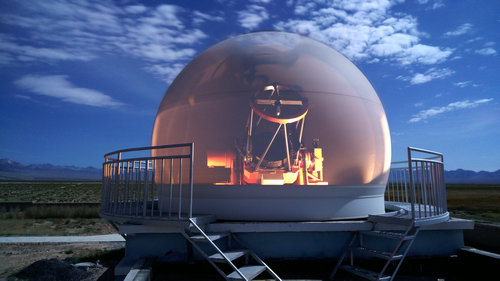Just after 0 o’clock on August 30th, the one-meter telescope of SONG project successfully acquired temporal spectrum of gamma Cephei by connecting high-resolution spectrometer of Coudé focus. It marked that SONG project team reached a preliminary goal for 4 years effort. The data we acquired had scientific significance because the stellar as a scientific target stellar was a candidate source for trial operation (fig.1). Gamma Cephei was a kind of red giant binaries with a period of 900 days exoplanet and its primary star had large amplitude vibrations which we would focus on testing stage.
China-SONG project included one-meter telescope, lucky imaging systems and high-resolution spectrometer and 50BiN China node network telescope which was fully invested by China West Normal University and also known as 50cm binoculars. It showed as fig.2 that the one-meter telescope was taken a photo for the first light. It was taken by Nubia Z9 with a long exposure mode when rotating dome after interior lighting. The telescope and terminal equipment development tasks were undertaken by Nanjing Institute of Astronomical Optics & Technology, CAS. This system was equipped with thin mirror active optics, lucky Imaging and high-resolution view speed measurement of Iodine box selection (R=60000-120000,RV=1m/s).
The equipment would be served for two main scientific targets of stellar physics research: one was detecting exoplanets based on micro-lensing method of lucky Imaging technique, and the other one was to research the internal structure of stellar based on asteroseismology method of radial velocity. They were typical scientific objectives of time domain astronomy and their scientific results depended on network construction. China-SONG was the first node of international network and was also the second node of successful operation.
The success of China-SONG meant that SONG project entered into official network operation after single-node operation of Danish SONG-Hertzsprung telescope which was extremely important to achieve the network scientific objectives. After achieving initial light, all workers in observation station including Frank Grundahl and MadsAndersen who came from Aarhus University conducted a simple ceremony to celebrate the moment.
Achieving first light is the first stage to operate the equipment scientifically and the next work will realize joint operation on automatic control and scientific instruments. Currently a lot of aspects of the software work will be required in-depth development to achieve automatic unattended global network node.
Commissioning of telescope and instrument systems is proposed at least one year. From the preliminary analysis, the system has realized scientific technical indicators totally. The value of spectrometer resolution is higher than 120000 (the result from thorium Argon spectrum official test) and the measurement of radial velocity accuracy is 3m /sec. During the depth of debugging, after stability of instrument performance, we will be able to achieve the expected level of one-meter observation accuracy of stellar radial velocity.
This equipment will provide unique platform for domestic stellar physics research to carry out the stellar vibrations, exoplanets, Doppler imaging, analysis, and another research such as the stellar element abundances analysis.

Fig.1 a period spectrum of Gamma Cephei (Exposure time: 120s; R=80,000; S/N=140; radial velocity accuracy is about 3m/s; the green solid line superimposed is high-resolution Standard spectrum.)

Fig2. The photo after first light of SONG one-meter telescope